Data Acquisition for Condition Monitoring in Tactical Vehicles: On-Board Computer Development
Abstract
1. Introduction
- Tactical radio systems have limited bandwidth and unstable connections for sending data in real time in contrast to industrial fleets, which use commercial networks.
- The operating conditions of the on-board device can be extreme and situations of mechanical and environmental stress may occur, making it necessary to design the system in a resistant way and create rugged devices.
- The regulation and validation of on-board devices in tactical vehicles has many restrictions, which are not only physical restrictions but are also linked to military regulation.
- The volume of data needed for reliable data-driven maintenance, as well as the transmission of this much data is challenging.
- The on-board device is in the acquisition stage: In this stage, the device only stores, translates, and exchanges vehicle data with the systems. In this case, the on-board device is optimized to store the information to be extracted in the next maintenance review.
- The on-board device is in operation mode: In this stage, the on-board device continues to store the information; however, it also stores the maintenance models that are created from the data extracted in the first stage, and only the alarms or event that are generated are transmitted thanks to the processing at the edge. This part of the development is not included in this paper.
- The design and implementation of an on-board device in a tactical vehicle is presented.
- The design of the acquisition infrastructure is created as needed for health and use monitoring system (HUMS) integration and deployment.
- The proposed on-board device is in accordance with current military regulations and standards.
- The application is presented in a real case involving tactical vehicles deployed in conflict zones.
2. Literature Review
3. Materials and Methods
4. Results and Discussion
4.1. Test Context, Environment, and Data Sources
4.2. Test Methodology and Metrics
4.3. Discussion
5. Conclusions
Author Contributions
Funding
Informed Consent Statement
Acknowledgments
Conflicts of Interest
References
- Xu, P.; Liu, R.; Sun, Q.; Jiang, L. Dynamic-Time-Warping-Based Measurement Data Alignment Model for Condition-Based Railroad Track Maintenance. IEEE Trans. Intell. Transp. Syst. 2015, 16, 799–812. [Google Scholar] [CrossRef]
- Endrenyi, J.; Aboresheid, S.; Allan, R.; Anders, G.; Asgarpoor, S.; Billinton, R.; Chowdhury, N.; Dialynas, E.; Fipper, M.; Fletcher, R.; et al. The present status of maintenance strategies and the impact of maintenance on reliability. IEEE Trans. Power Syst. 2001, 16, 638–646. [Google Scholar] [CrossRef]
- Mizanur, R.; Rashid, M.M.; Rahman, A.; Alam, A.H.M.Z.; Ihsan, S.; Mollik, M.S. Analysis of the internal temperature of the cells in a battery pack during SOC balancing. IOP Conf. Ser. Mater. Sci. Eng. 2017, 184, 12014. [Google Scholar] [CrossRef]
- Zdravkovic, J.; Ilic, N.; Stojanovic, D. Big Telemetry Data Analytics for Vehicle Fault Detection. In Proceedings of the 2021 15th International Conference on Advanced Technologies, Systems and Services in Telecommunications (TELSIKS), Nis, Serbia, 20–22 October 2021; pp. 245–248. [Google Scholar] [CrossRef]
- Liu, Y.; Le Clair, A.; Doude, M.; Burch, V.R.F. Development of a Data Acquisition System for Autonomous Vehicle Systems. Int. J. Veh. Struct. Syst. 2018, 10, 251–256, ISSN 0975-3060. [Google Scholar] [CrossRef]
- Wang, Z.; Song, C.; Zhang, L.; Zhao, Y.; Liu, P.; Dorrell, D.G. A Data-Driven Method for Battery Charging Capacity Abnormality Diagnosis in Electric Vehicle Applications. IEEE Trans. Transp. Electrif. 2021, 8, 990–999. [Google Scholar] [CrossRef]
- AUTOSAR Automotive Open System Architecture. Available online: https://www.autosar.org/ (accessed on 28 May 2023).
- ISO 26262-1:2011; Road Vehicles—Functional Safety—Part 1: Vocabulary. ISO Standards: Geneva, Switzerland, 2011. Available online: https://www.iso.org/standard/43464.html (accessed on 28 May 2023).
- Kegenbekov, Z.; Saparova, A. Using the MQTT Protocol to Transmit Vehicle Telemetry Data. Transp. Res. Procedia 2022, 61, 410–417, ISSN 2352-1465. [Google Scholar] [CrossRef]
- Pradhan, M.; Gokgoz, F.; Bau, N.; Ota, D. Approach towards application of commercial off-the shelf Internet of Things devices in the military domain. In Proceedings of the 2016 IEEE 3rd World Forum on Internet of Things (WF-IoT), Reston, VA, USA, 12–14 December 2016; pp. 245–250. [Google Scholar] [CrossRef]
- White, T.; Smith, K.; Raistrick, C. The UK’s approach to vehicle systems integration and model-based standardisation. In Proceedings of the Ground Vehicle Systems Engineering & Technology Symposium (GVSETS), Novi, MI, USA, 7–9 August 2018. [Google Scholar]
- European Defense Agency (EDA). LAVOSAR II Land Vehicle with Open System Architecture. Available online: https://www.tecnologiaeinnovacion.defensa.gob.es/Lists/Publicaciones/Attachments/192/boletin_tecnologico_42.pdf (accessed on 28 May 2023).
- NGVA Nato Generic Vehicle Architecture. Available online: https://www.natogva.org/ (accessed on 28 May 2023).
- Generic Vehicle Architecture, Defence Standard 23-09, 20 August 2010. Available online: https://www.dds-foundation.org/sites/default/files/DefStan_23_03_GVA_00000100.pdf (accessed on 28 May 2023).
- Ota, D. Towards Verification of NATO Generic Vehicle Architecture-Based Systems. Condition monitoring and diagnostics of machines—Prognostics—Part 1: General guidelines. In Proceedings of the Twenty-First International Command and Control Research and Technology, London, UK, 6–8 September 2015. [Google Scholar]
- STANAG 4754; Nato Generic Vehicle Architecture (NGVA) for Land Systems. NATO: Brussels, Belgium, 2023.
- Porotsky, S.; Bluvband, Z. Remaining useful life estimation for systems with non-trend ability behaviour. In Proceedings of the IEEE Conference on Prognostics and Health Management, Beijing, China, 23–25 May 2012; pp. 1–6. [Google Scholar] [CrossRef]
- Wang, Q.; Zheng, S.; Farahat, A.; Serita, S.; Gupta, C. Remaining Useful Life Estimation Using Functional Data Analysis. In Proceedings of the 2019 IEEE International Conference on Prognostics and Health Management (ICPHM), San Francisco, CA, USA, 17–20 June 2019; pp. 1–8. [Google Scholar] [CrossRef]
- Lei, Y.; Li, N.; Gontarz, S.; Lin, J.; Radkowski, S.; Dybala, J. A Model-Based Method for Remaining Useful Life Prediction of Machinery. IEEE Trans. Reliab. 2016, 65, 1314–1326. [Google Scholar] [CrossRef]
- Turo, T.; Ota, D.; Charchalakis, P. Creation of a Multinational Centre of Excellence on Vetronics to support NATO GVA. In Proceedings of the 2019 International Conference on Military Technologies (ICMT), Brno, Czech Republic, 30–31 May 2019; pp. 1–8. [Google Scholar] [CrossRef]
- MILCAN Deterministic Protocol that Can Be Applied to Controller Area Network (CAN) Technology. Available online: https://www.milcan.org/files/MilCAN_A_Complete_Rev3_.pdf (accessed on 28 May 2023).
- ISO 11898-1:2015; Road Vehicles—Controller Area Network (CAN). ISO Standards: Geneva, Switzerland, 2015. Available online: https://www.iso.org/standard/63648.html (accessed on 28 May 2023).
- SAE J1939; Recommended Practice for a Serial Control and Communications Vehicle Network. SAE International Standards: Warrendale, PA, USA, 2005. Available online: https://www.sae.org/standardsdev/groundvehicle/j1939a.htm (accessed on 28 May 2023).
- CAN Open-The Standardized Embedded Network. Available online: https://www.cancia.org/can-knowledge/canopen/canopen/ (accessed on 28 May 2023).
- De Hoog, J.; Bogaerts, T.; Casteels, W.; Mercelis, S.; Hellinckx, P. Online reverse engineering of CAN data. Internet Things 2020, 11, 100232. [Google Scholar] [CrossRef]
- SAE J1939/71; Vehicle Application Layer J1939/71_201610, SAE J1939/71. SAE International Standards: Warrendale, PA, USA, 2016. Available online: https://www.sae.org/standards/content/j1939/71_201610/ (accessed on 28 May 2023).
- SAE J1708_201609; Serial Data Communications between Microcomputer Systems in Heavy-Duty Vehicle Applications, SAE J1708. SAE International Standards: Warrendale, PA, USA, 2016. Available online: https://www.sae.org/standards/content/j1708_201609/ (accessed on 28 May 2023).
- SAE J1939/73; Application Layer-Diagnostics J1939/73_202208, SAE J1939-73. SAE International Standards: Warrendale, PA, USA, 2022. Available online: https://www.sae.org/standards/content/j1939/73_202208/ (accessed on 28 May 2023).
- PICAN 2 CAN-Bus Board for Raspberry Pi 2 3. Available online: https://www.skpang.co.uk/products/pican2-can-bus-board-for-raspberry-pi-2-3-with-smps (accessed on 28 May 2023).
- SAE J2012DA; Digital Annex of Diagnostic Trouble Code Definitions and Failure Type Byte Definitions, SAE J2012DA. SAE International Standards: Warrendale, PA, USA, 2018. Available online: https://www.sae.org/standards/content/j2012da_201812/ (accessed on 28 May 2023).
- MDF4 Measuring Data Format. Available online: https://www.asam.net/standards/detail/mdf/wiki/ (accessed on 28 May 2023).
- Fast Python Reader and Editor for ASAM MDF/MF4 (Measurement Data Format) Files. Available online: https://github.com/danielhrisca/asammdf (accessed on 28 May 2023).
- CANDUMP, CAN Utils. Available online: https://elinux.org/Can-utils (accessed on 28 May 2023).
- CAN BUS Tools. Available online: https://cantools.readthedocs.io/en/latest/ (accessed on 28 May 2023).
- DBC Vehicles. Available online: https://docs.openvehicles.com/en/latest/components/vehicle_dbc/docs/dbc-primer.html (accessed on 28 May 2023).
- Python3 Libs and Scripts for Human Readable J1939 Can Dump Logs. Available online: https://github.com/nmfta-repo/pretty_j1939 (accessed on 28 May 2023).
- Object Management Group. OMG. Available online: https://www.omg.org/ (accessed on 28 May 2023).
- The US Department of Defense. The Data Distribution Service. Available online: https://www.omg.org/news/meetings/tc/dc-13/specialevents/dds-pdfs/DDS_Exec_Brief-v20d-public.pdf (accessed on 28 May 2023).
- Amazon S3 Protocol. Available online: https://docs.aws.amazon.com/AmazonS3/latest/API/Welcome.html (accessed on 28 May 2023).
- High Performance Storage for AI. MinIO. Available online: https://min.io (accessed on 28 May 2023).
- Terreros, O.; Jose, F. Controller Area Network Data for Fault Prognostics. Harvard Dataverse, V2. 2022. Available online: https://dataverse.harvard.edu/dataset.xhtml?persistentId=doi:10.7910/DVN/ZUPEIC (accessed on 28 May 2023).
- SAE J1939/21; Data Link Layer. SAE International Standards: Warrendale, PA, USA, 2021. Available online: https://www.sae.org/standards/content/j1939/21_202109/ (accessed on 28 May 2023).
- Qiao, Z.; Shu, X. Coupled neurons with multi-objective optimization benefit incipient fault identification of machinery. Chaos Solitons Fractals 2021, 145, 110813. [Google Scholar] [CrossRef]

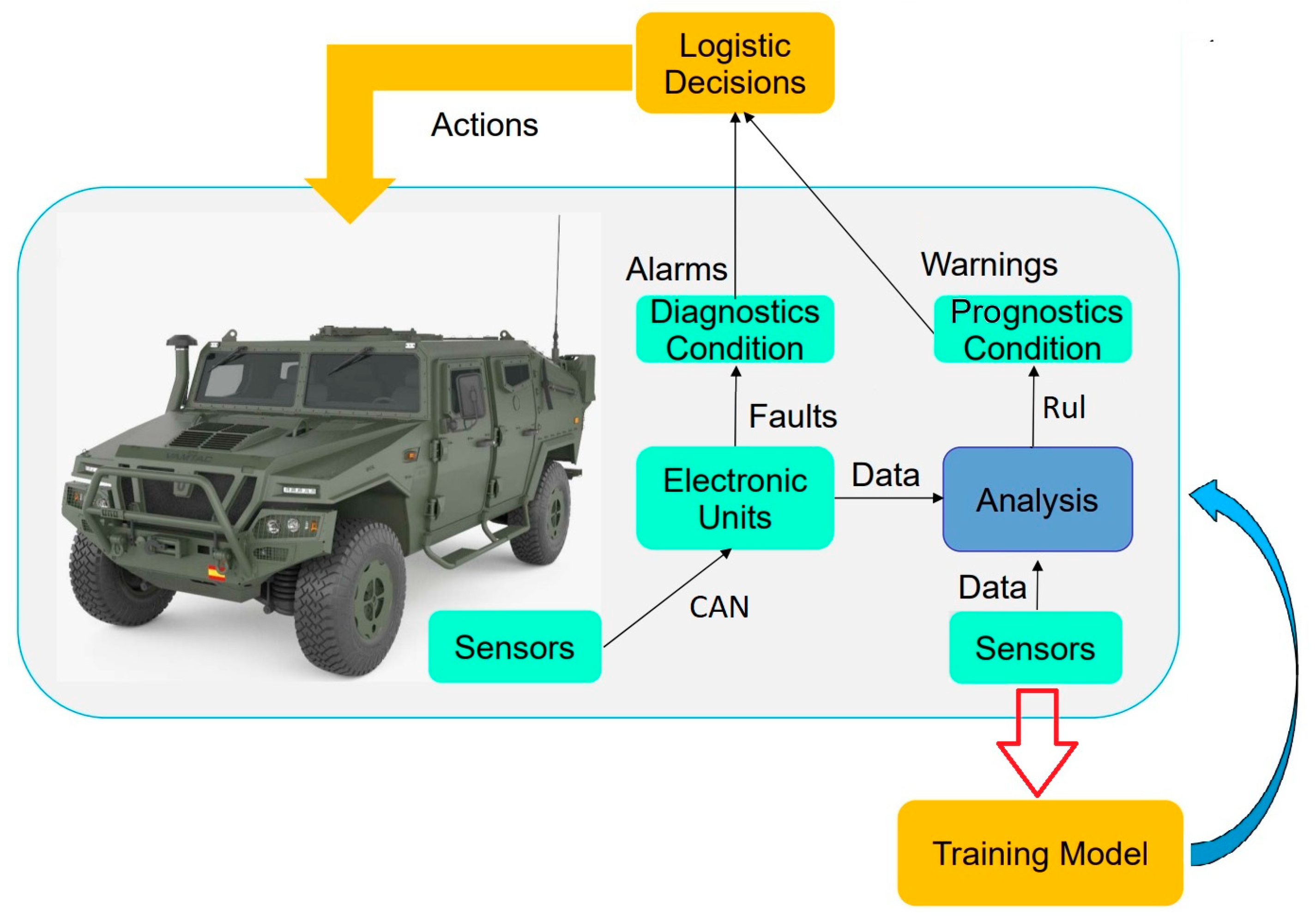
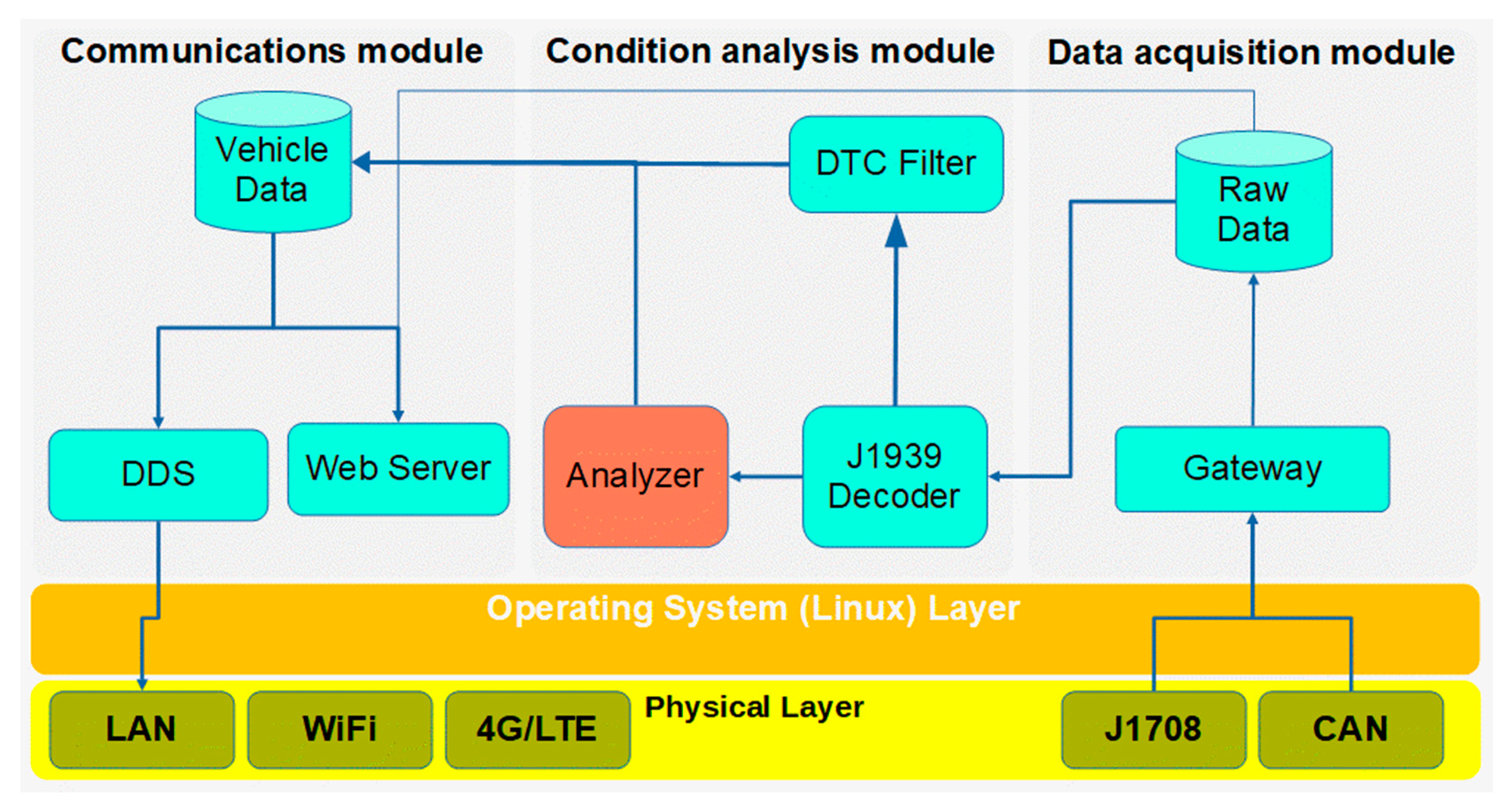
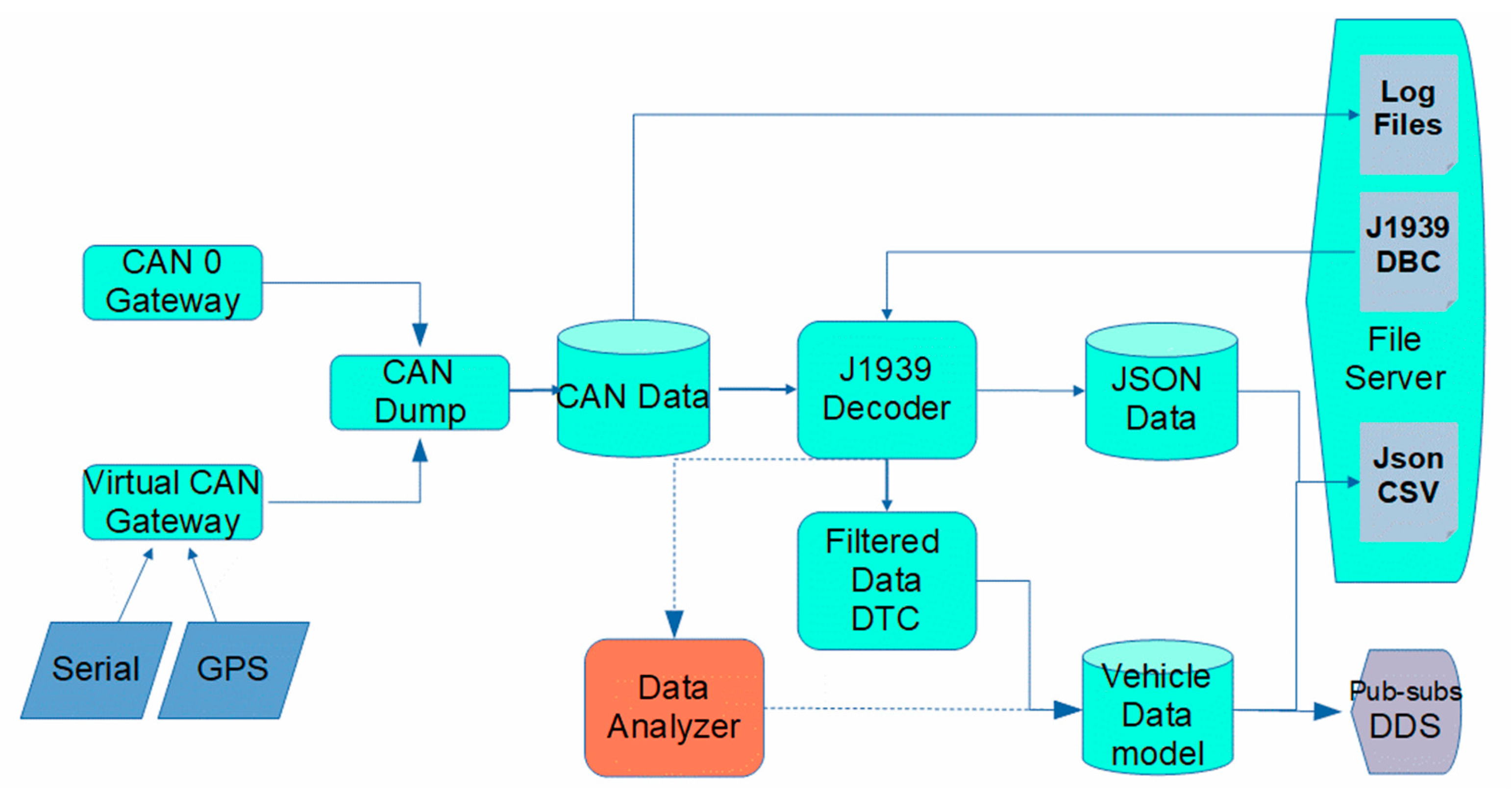
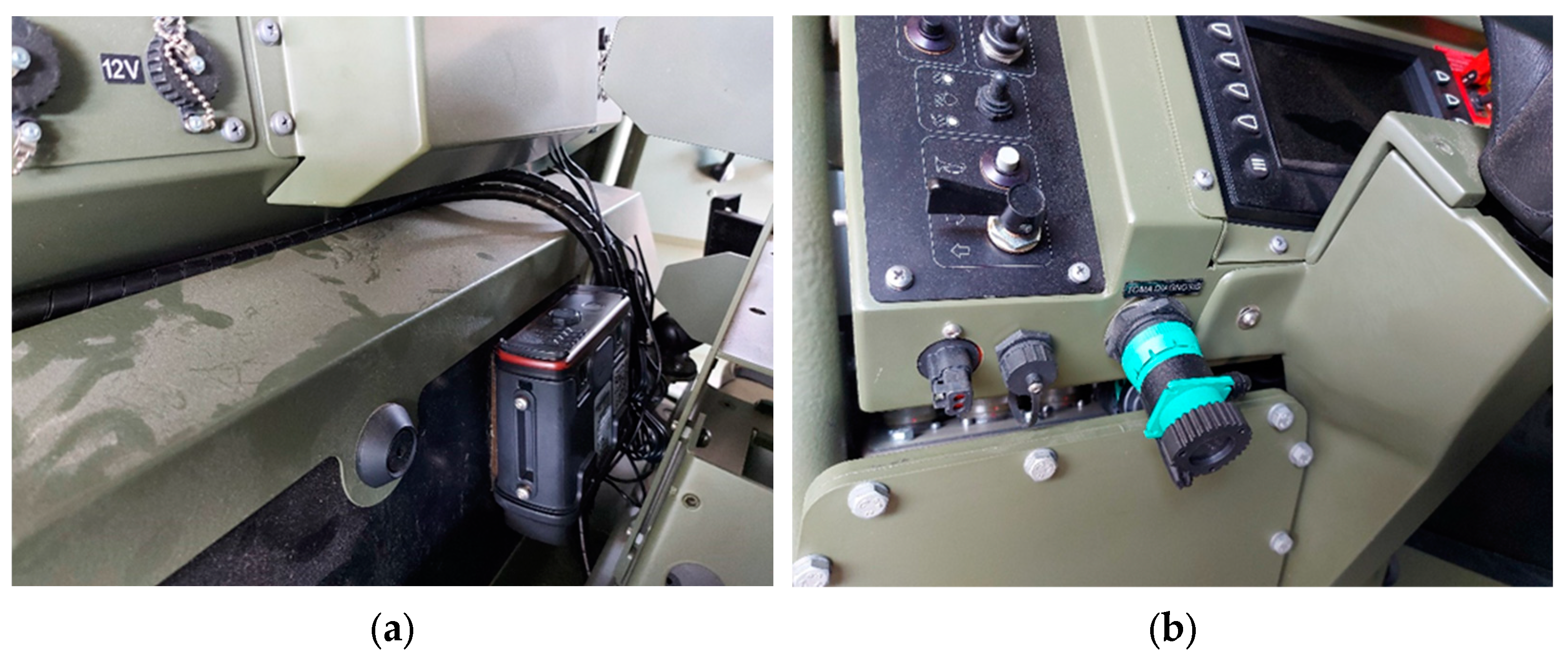

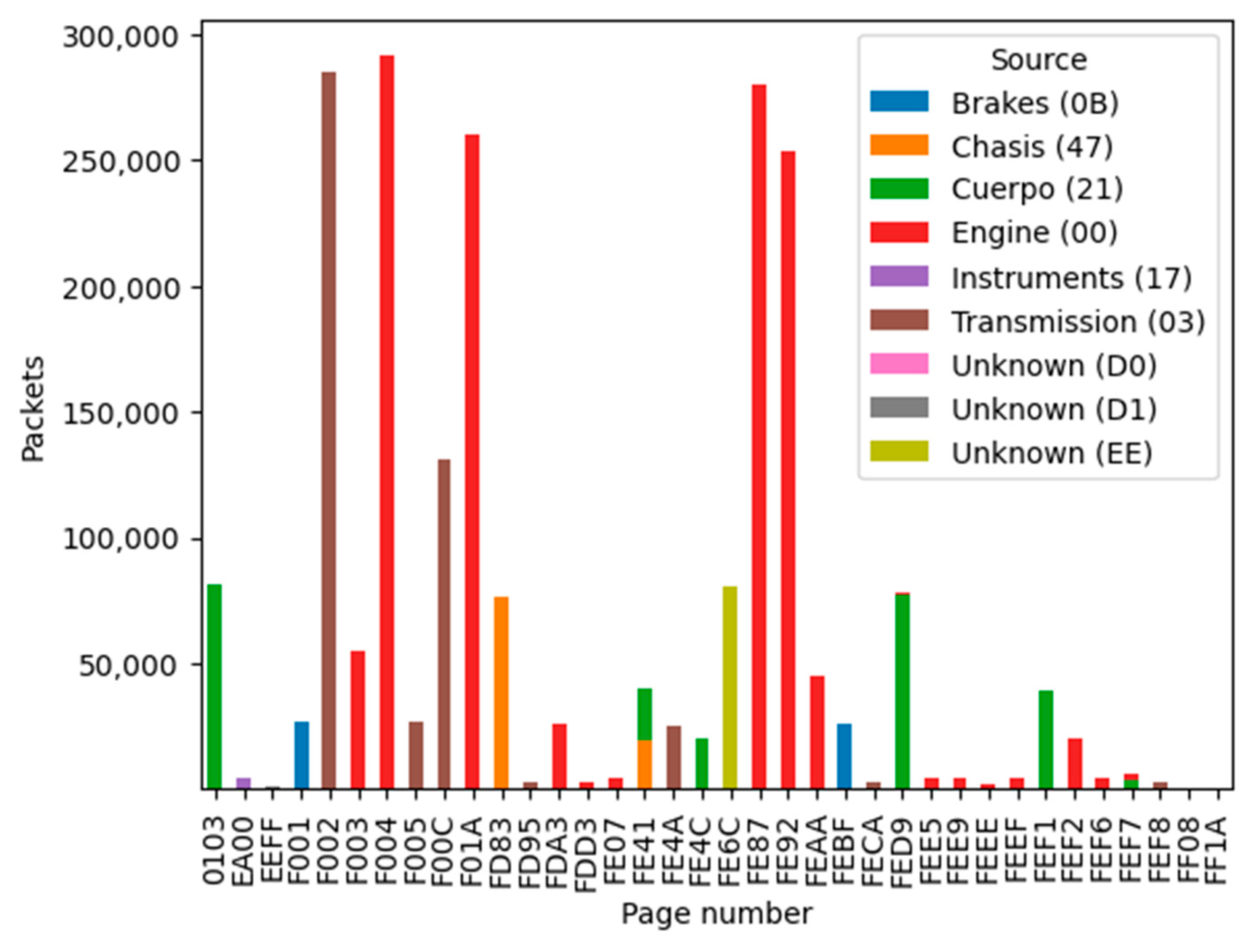
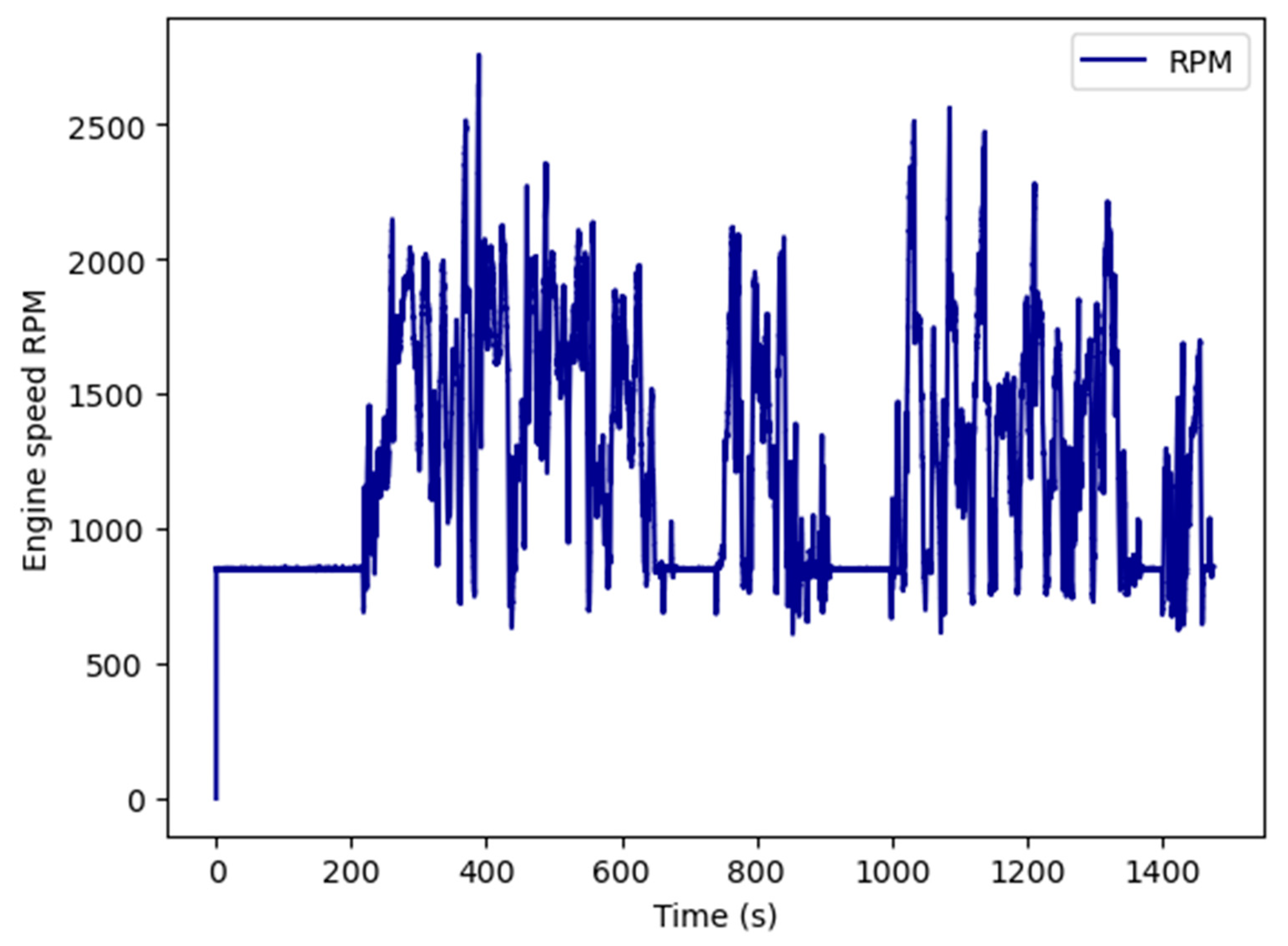
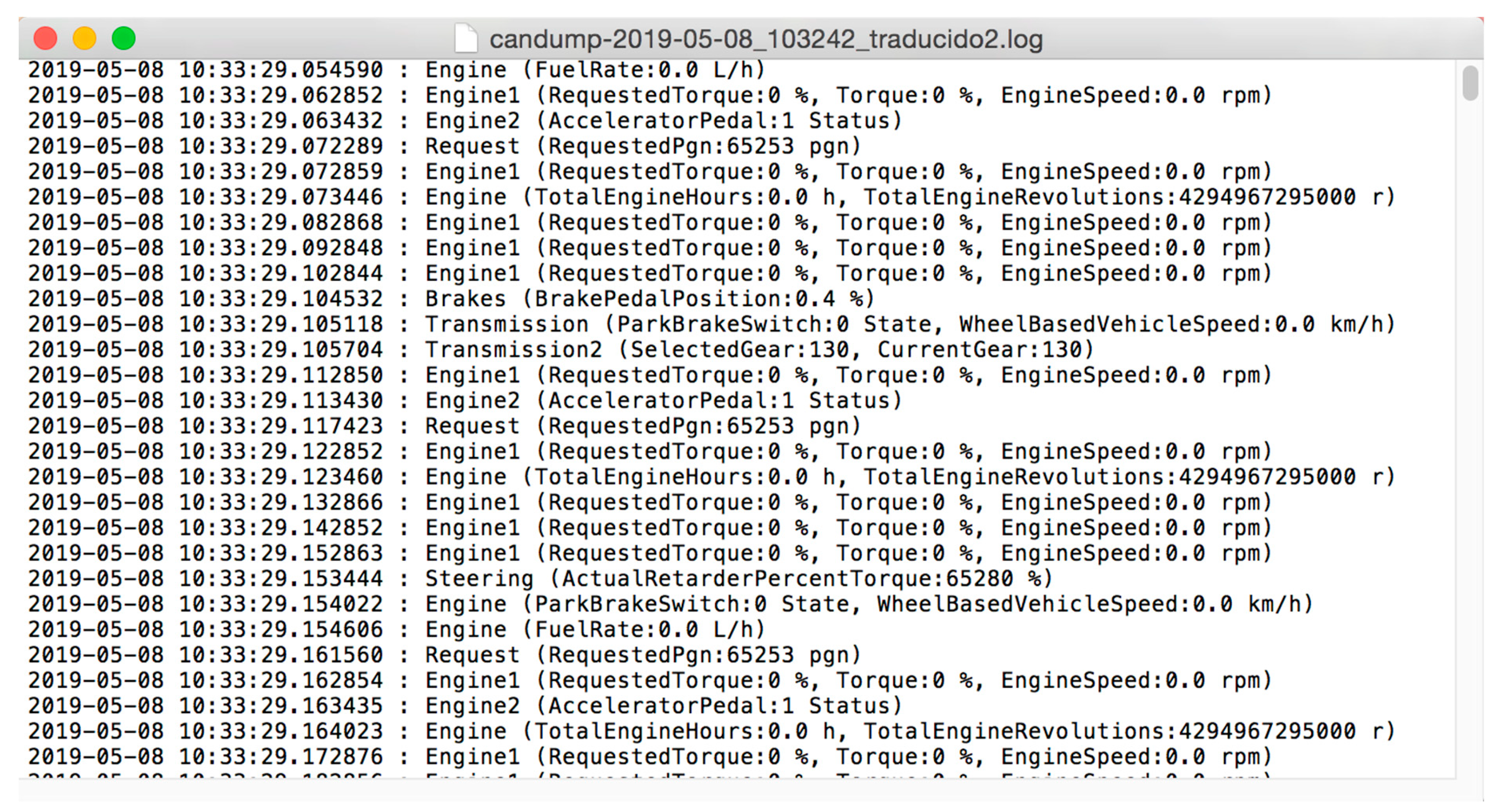
| Code (Hex) | Frame Group | Frame Description | Subsystem | Source Address (Hex) |
|---|---|---|---|---|
| 0000 | TSC1 | Torque/Speed Control | Engine | 00 |
| F000 | ERC1 | Retarder Controller | Retarder | 0F |
| F001 | EBC1 | Brake Controller | Brakes | 0B |
| F002 | ETC1 | Transmission Controller 1 | Transmission | 03 |
| F003 | EEC2 | Engine Controller 2 | Engine | 00 |
| F004 | EEC1 | Engine Controller 1 | Engine | 00 |
| F005 | ETC2 | Transmission Controller 2 | Transmission | 03 |
| F009 | VDC2 | Vehicle Dynamic Control 2 | Body | 21 |
| FE6C | TCO1 | Tachograph | Body | 21 |
| FE87 | IT6 | Ignition Timing 6 | Engine | 00 |
| FEEE | ET1 | Engine Temperature | Engine | 00 |
| FEEF | EFLP | Engine Fluid Level/Pressure | Engine | 00 |
| FEF1 | CCVS1 | Cruise Control/Vehicle Speed | Body | 21 |
| FEF2 | LFE | Fuel Economy Liquid | Engine | 00 |
| FECA | DM1 | Active Diagnostic Trouble Code | Engine | 00 |
| Page (Hex) | Group (Code) | System | Frames (Number) | Frames (%) | GTR (s) | SBR (Kbyte) | TRR (Kbps) |
|---|---|---|---|---|---|---|---|
| 0000 | TSC1 | Engine | 31,734 | 1.39 | 0.047 | 10.212 | 1.92 |
| F000 | ERC1 | Brake | 15,189 | 0.66 | 0.1 | 4.8 | 0.96 |
| F005 | ETC1 | Transmission | 15,119 | 0.66 | 0.1 | 4.8 | 0.96 |
| FEF7 | ETC2 | Transmission | 151,880 | 6.69 | 0.01 | 48.0 | 9.6 |
| F003 | EEC2 | Engine | 30,377 | 1.33 | 0.05 | 9.6 | 1.92 |
| F004 | EEC1 | Engine | 151,886 | 6.69 | 0.01 | 48.0 | 9.6 |
| FEEE | ET1 | Engine | 1519 | 0.06 | 1.0 | 0.48 | 0.096 |
| FECA | DM1 | Diagnostic 1 | 1519 | 0.06 | 1.0 | 0.48 | 0.096 |
| FEF2 | LFE | Engine | 15,189 | 0.66 | 0.1 | 4.8 | 0.96 |
Disclaimer/Publisher’s Note: The statements, opinions and data contained in all publications are solely those of the individual author(s) and contributor(s) and not of MDPI and/or the editor(s). MDPI and/or the editor(s) disclaim responsibility for any injury to people or property resulting from any ideas, methods, instructions or products referred to in the content. |
© 2023 by the authors. Licensee MDPI, Basel, Switzerland. This article is an open access article distributed under the terms and conditions of the Creative Commons Attribution (CC BY) license (https://creativecommons.org/licenses/by/4.0/).
Share and Cite
Ochando, F.J.; Cantero, A.; Guerrero, J.I.; León, C. Data Acquisition for Condition Monitoring in Tactical Vehicles: On-Board Computer Development. Sensors 2023, 23, 5645. https://doi.org/10.3390/s23125645
Ochando FJ, Cantero A, Guerrero JI, León C. Data Acquisition for Condition Monitoring in Tactical Vehicles: On-Board Computer Development. Sensors. 2023; 23(12):5645. https://doi.org/10.3390/s23125645
Chicago/Turabian StyleOchando, Francisco Jose, Antonio Cantero, Juan Ignacio Guerrero, and Carlos León. 2023. "Data Acquisition for Condition Monitoring in Tactical Vehicles: On-Board Computer Development" Sensors 23, no. 12: 5645. https://doi.org/10.3390/s23125645
APA StyleOchando, F. J., Cantero, A., Guerrero, J. I., & León, C. (2023). Data Acquisition for Condition Monitoring in Tactical Vehicles: On-Board Computer Development. Sensors, 23(12), 5645. https://doi.org/10.3390/s23125645







